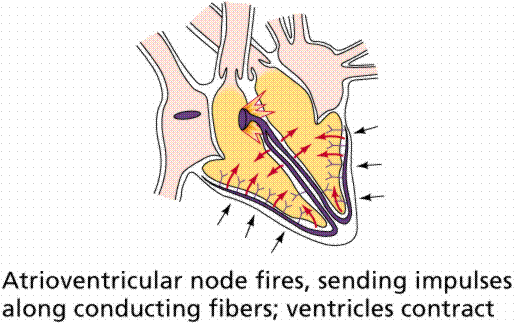| << Chapter < Page | Chapter >> Page > |
| Figure 13. The contraction of the heart and the action of the nerve nodes located on the heart. Images from Purves et al., Life: The Science of Biology , 4th Edition, by Sinauer Associates ( www.sinauer.com ) and WH Freeman ( www.whfreeman.com ), (please get permission) |
 |
 |
 |
| Figure 15. Normal cardiac pattern (top) and some abnormal patterns (bottom). Images from Purves et al., Life: The Science of Biology , 4th Edition, by Sinauer Associates ( www.sinauer.com ) and WH Freeman ( www.whfreeman.com ), (please contact for permission). |
 |
 |
Investigation: Heart Health and Measuring Heart rate
Part 1: Investigating your cardiovascular fitness
Aim :To investigate your heart rate before, during and after strenuous aerobic exercise.
Method :
Results : Record results in a table like the one indicated below
| TIME | HEART RATE (BEATS PER MINUTE) |
| Before exercise (resting) | |
| 0 min (immediately after exercise) | |
| 1 min (after exercise) | |
| 2 min | |
| 3 min | |
| 4 min | |
| 5 min |
Draw a line graph to illustrate your results on the following axis (show the resting pulse rate as a separate dotted line on the axis).
Mark allocation: heading x-axis scale x-axis label
y-axis scale y-axis label plotting graph
neat and done in pencil
Questions:
1.Write a hypothesis for this investigation.
2.Write down the independent variable.
3.Write down the dependent variable.
4.Name ONE factor that must be kept constant during this investigation.
5.Write down TWO ways in which the accuracy of this investigation can be
improved.
6.What conclusions can be made about your cardiovascular fitness?
7.Explain why the heart rate increases during exercise?
Part 2: Investigating your family’s heart health:
Instructions:
i. Do you smoke?
ii. Are you overweight?
iii. Do you exercise regularly?
iv. Do you follow a healthy diet (low fat, low salt)
v. Do you have your blood pressure checked regularly?
vi. Do you have a family history of heart and circulatory disease?
3.Record the results in your table. Also indicated the score they obtained:
i. yes=0; no=5
ii. yes=0; no=5
iii. yes=5; no=0
iv. yes=5; no=0
v. yes=5; no=0
vii. yes=0; no=5

Notification Switch
Would you like to follow the 'Siyavula: life sciences grade 10' conversation and receive update notifications?